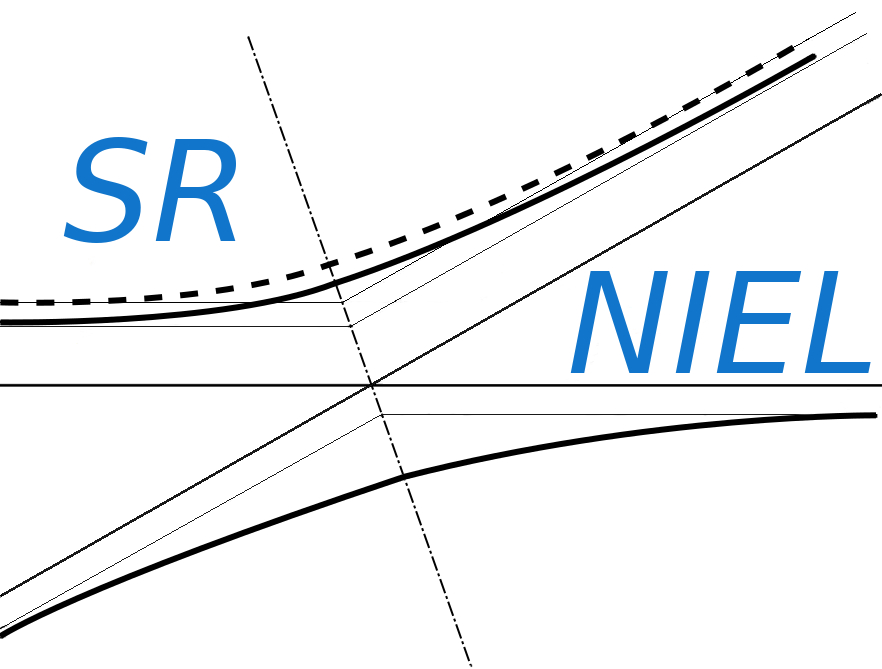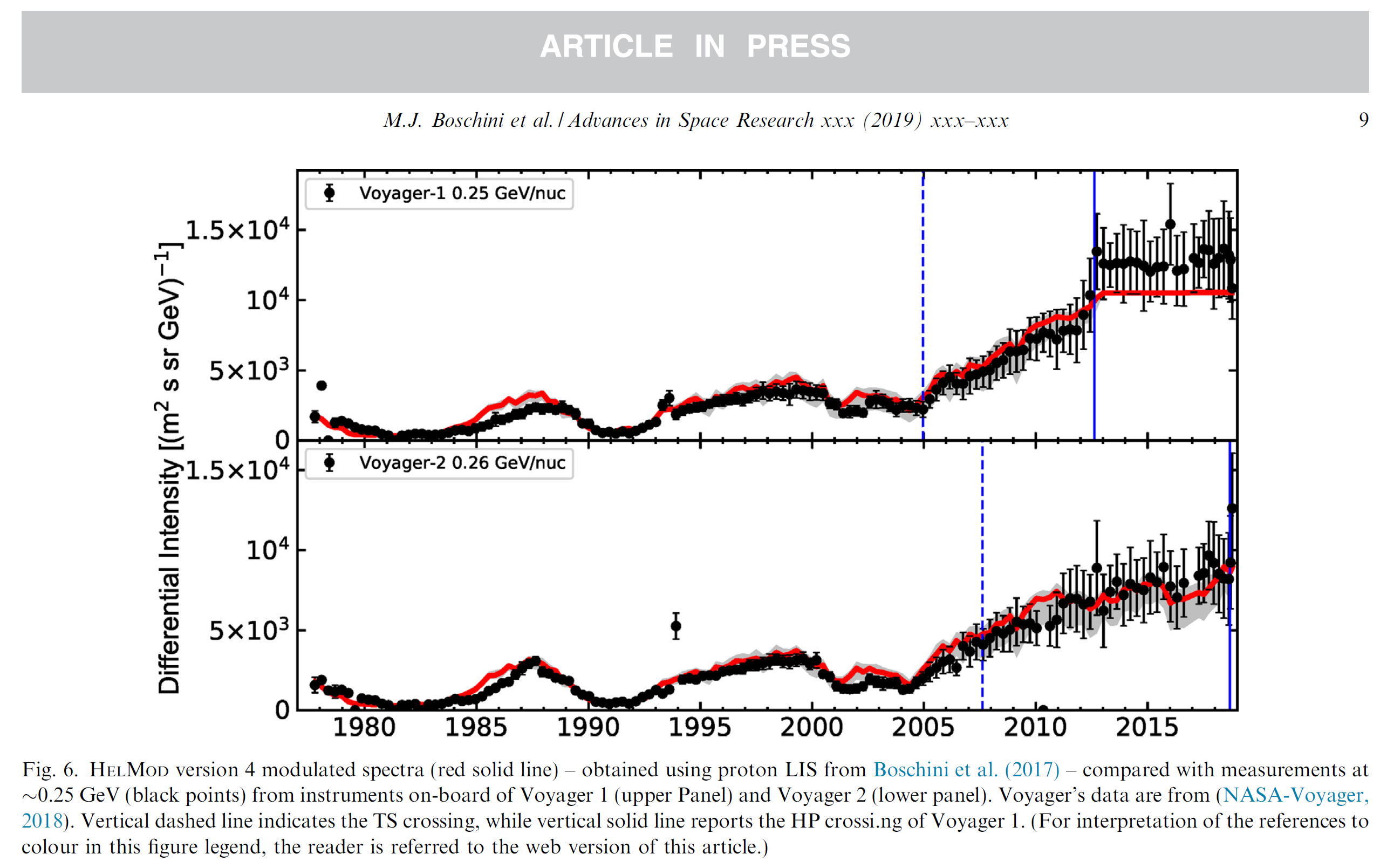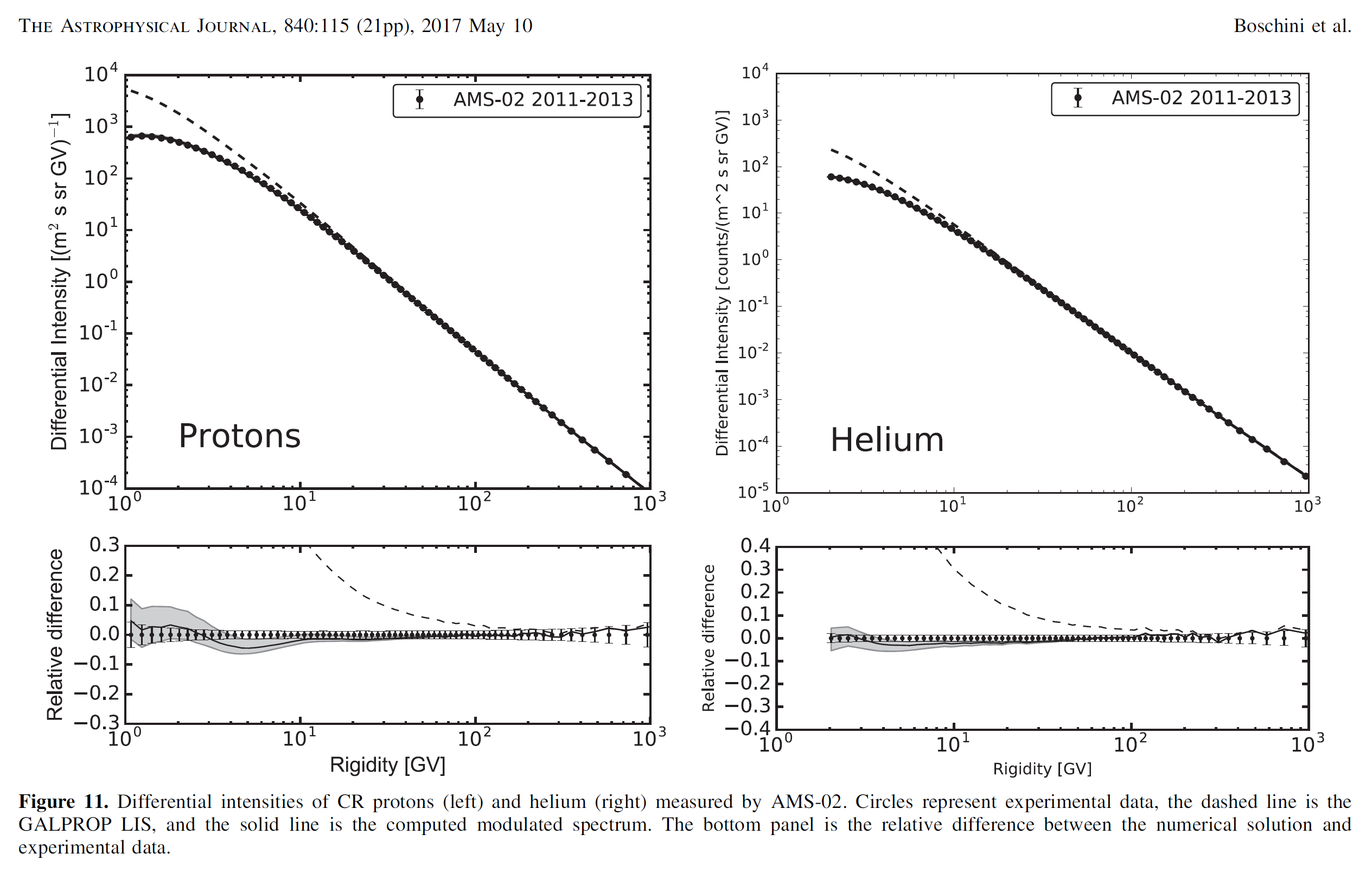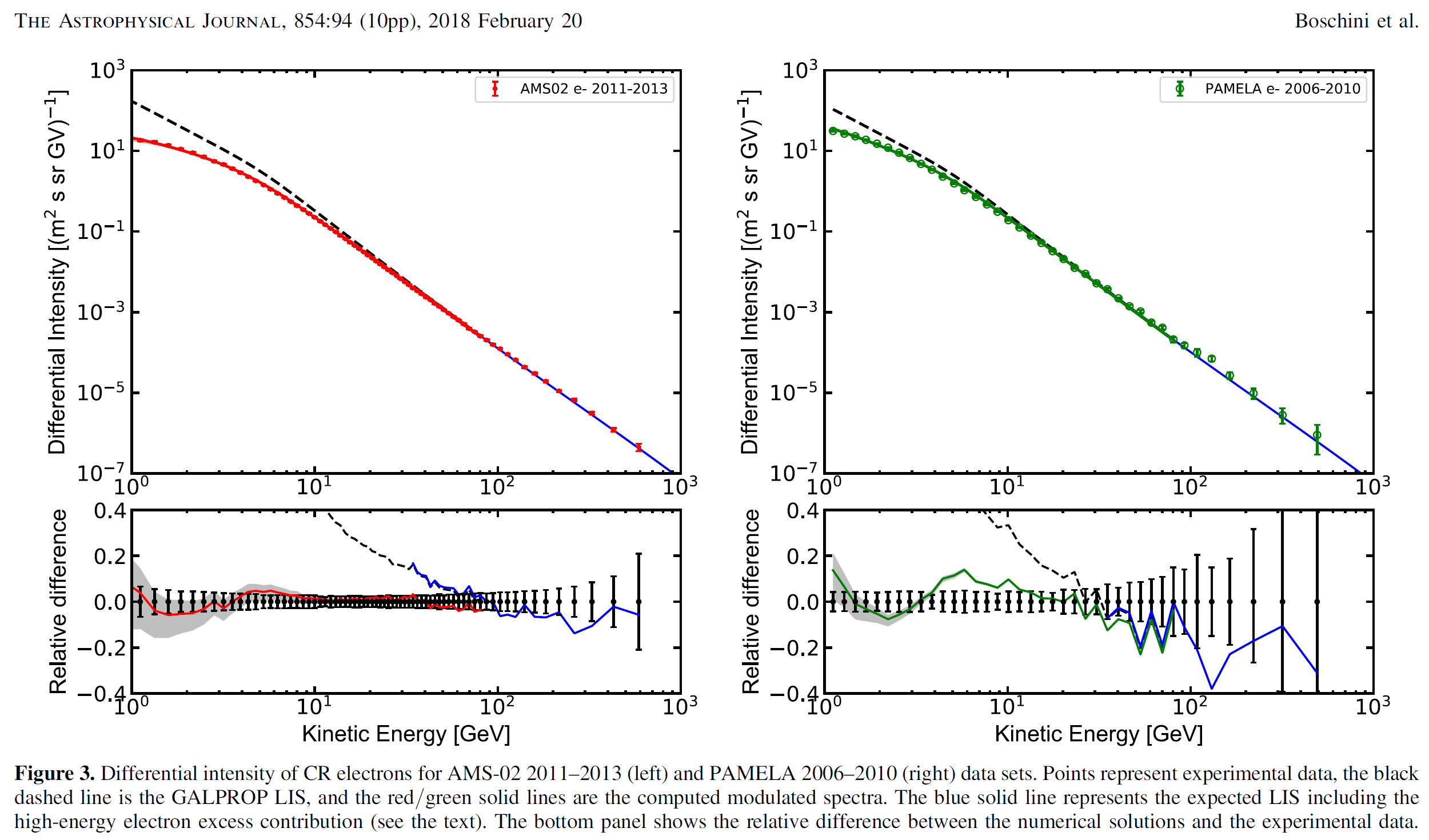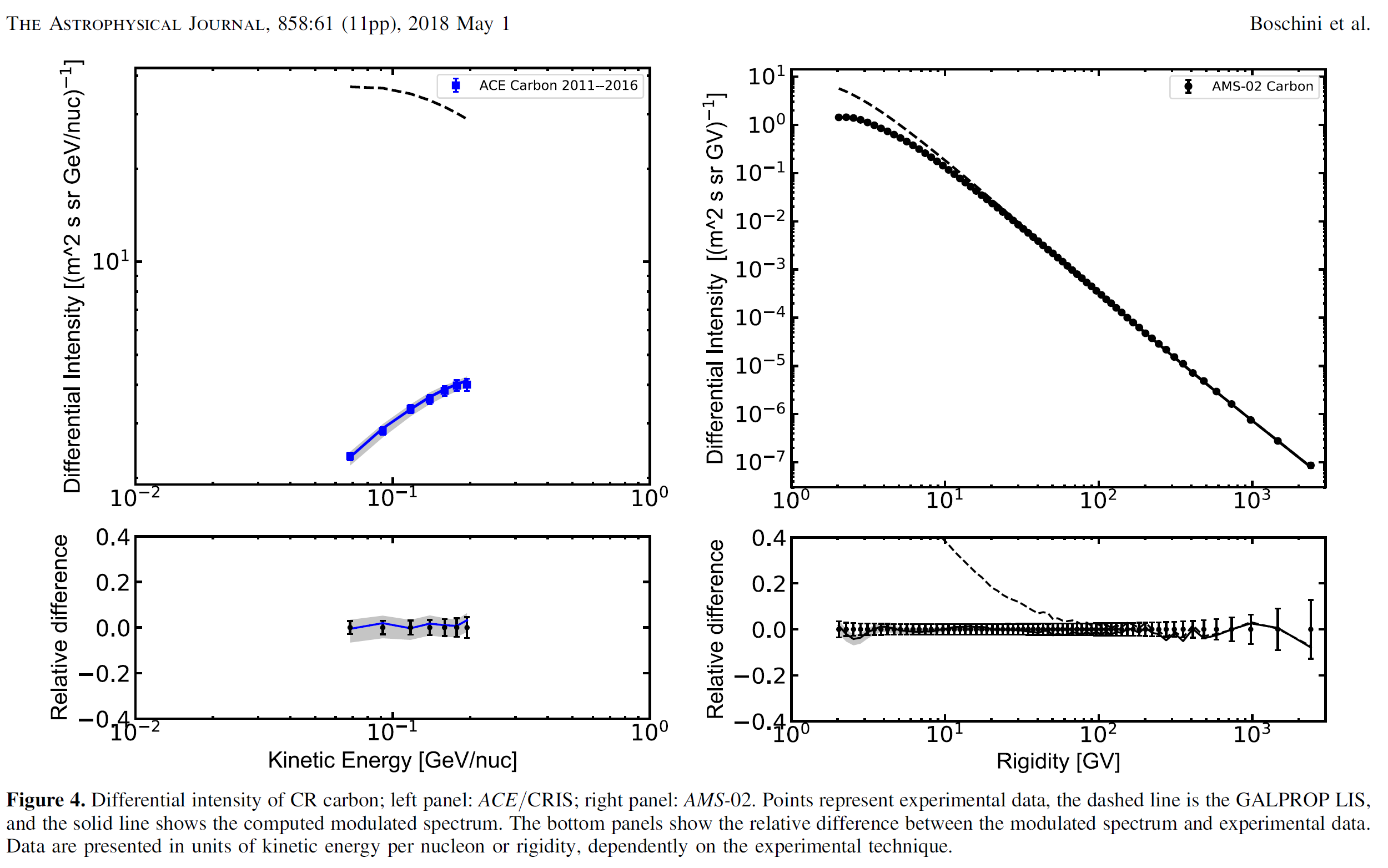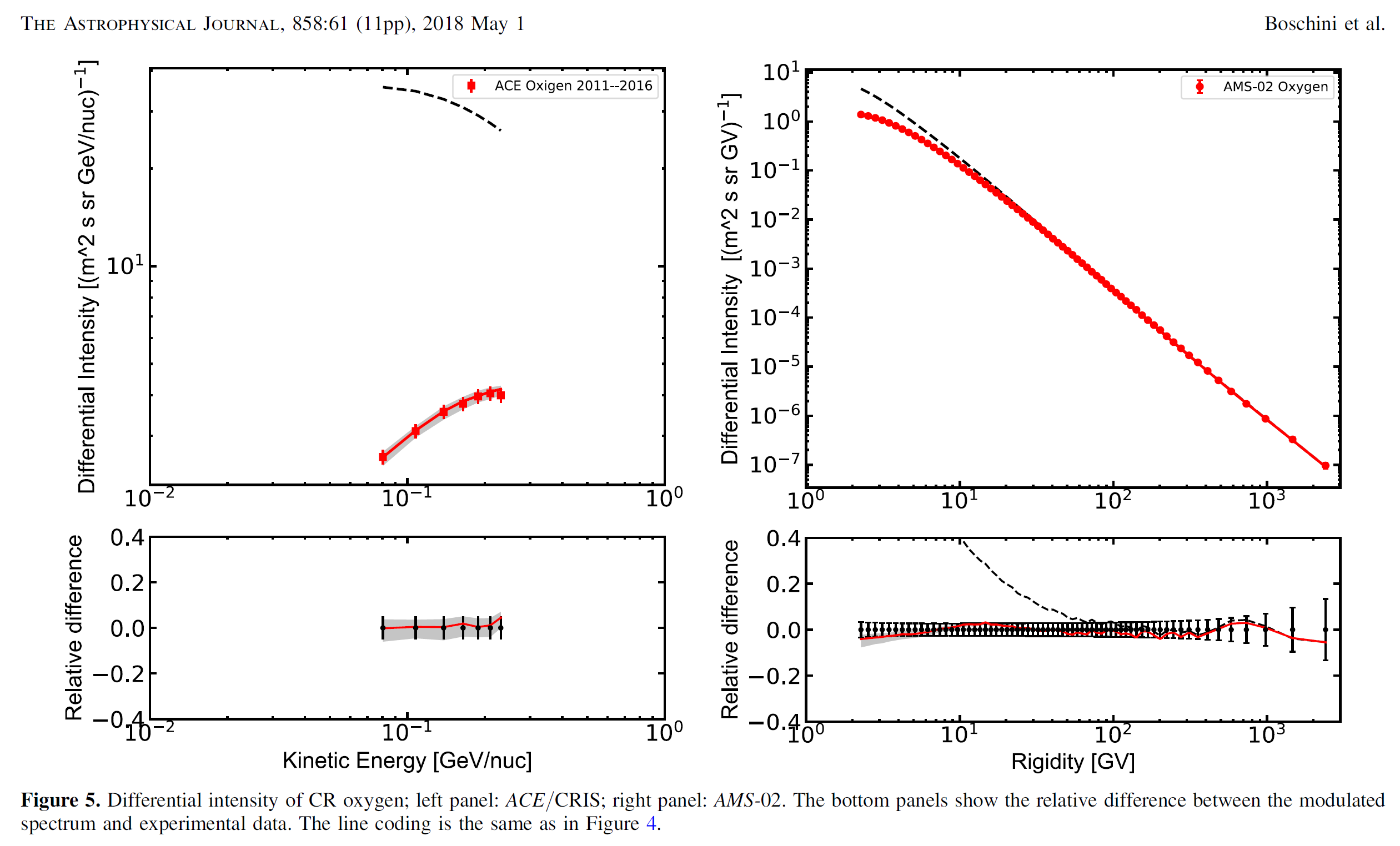HelMod - the solar modulation model used within SR-NIEL framework - is a well-known Monte Carlo code developed to describe the transport of GCRs through the heliosphere from the interstellar space down to Earth (e.g., [HelMod (2019)], Chapter 8 of [Leroy and Rancoita (2016)]).
In the current HelMod version 4 the modulation process, based on Parker’s equation, is applied to the propagation of GCRs in the inner and outer heliosphere, i.e., including the heliosheath. In fact, HelMod demonstrated to be capable of reproducing the fluxes observed by the Voyager probes in the inner and outer regions of heliosphere up to its border. The HelMod model reproduced protons, antiprotons, nuclei and electrons cosmic rays spectra observed - during solar cycles 23–24 and before - by several detectors, for instance, PAMELA, BESS, HEAO-3, ACE and AMS-02 (e.g., see [HelMod (2019)] and Selected published or in press HelMod spectra). In particular, the unprecedented accuracy of AMS-02 observations allowed one a better tuning on how solar modulation mechanisms are implemented inside the model.
Furthermore, the join GalProp-HelMod (2016) effort allowed one to determine local interstellar spectra (LIS) of protons, antiprotons, ions and electrons, whose set is gradually extended. The already available LISs of cosmic rays species - from which the HelMod modulated spectra can be derived - are listed in HelMod website. There, in fact, a user can require the HelMod spectra for specific past and future time periods or refer to published datasets (e.g., those from AMS-02, Pamela, etc.), i.e.,
- or single GCRs species and the future or past expected time interval can be chosen;
- or, for each published experimental datasets (e.g., those from AMS-02, Pamela, etc.), HelMod modulated spectra can be obtained regarding the time of observation, the type of investigated GCR species (e.g., proton, helium-nuclei, etc.) and, finally, the set of publised data
In the present webpage (e.g., see Comparison of solar modulation models with previously shown experimental data from AMS-02), a selection of observed spectra of GCRs species are reported together with the modulated spectra obtained from some currently used solar modulation models, in particular dealing with space radiation environment, i.e.,
- CREME version 96 [CREME (1996)] and version 2009 (e.g., see [CREME (2012)]) using the CREME FLUX module as available from CREME website upon registration;
- ISO-15390 model (e.g., see [ANSI (2004)]) using the package for galactic cosmic ray models as available from SPENVIS website upon registration;
- ISO(-15390)-DLR model (e.g., see [Matthiä et al (2013)]) using the web calculator as available from helmod.org website;
- HelMod (2019) model using the web calculator as available from helmod.org website.
Selected published or in press HelMod spectra
Figure 1. Reproduced from Figure 6 of [Boschini et al. (2019a)].
Figure 2. Reproduced from Figure 11 of [Boschini et al. (2017)]. AMS-02 proton data are from [Aguilar et al. (2015a)], AMS-02 helium data are from [Aguilar et al. (2015b)].
Figure 3. Reproduced from Figure 3 of [Boschini et al. (2018a)]. AMS-02 data (left panel) are from [Aguilar et al. (2014)], PAMELA data (right panel) are from [Adriani et al. (2011)].
Figure 4. Reproduced from Figure 4 of [Boschini et al. (2018b)]. ACE data (left panel) are from [George et al. (2009)], AMS-02 data (right panel) are from [Aguilar et al. (2017)].
Figure 5. Reproduced from Figure 5 of [Boschini et al. (2018b)]. ACE data (left panel) are from [George et al. (2009)], AMS-02 data (right panel) are from [Aguilar et al. (2017)].

Figure 6. Reproduced from Figure 4 of [Boschini et al. (2019b)].

Figure 7. Reproduced from Figure 10 of [Boschini et al. (2019b)].
Comparison of solar modulation models with previously shown experimental data from AMS-02
In the upper panels of Figures 8-15, the modulated spectra from CREME96, CREME2009, ISO-15390 and ISO-DLR are compared to both HelMod spectra and AMS02 data - which usually exhibit the highest experimental accuracy - for protons, helium-, lithium-, beryllium-, boron-, carbon-, nitrogen- and oxygen-nuclei. As a function of rigidity R, relative differences of the solar model differential intensities, φ(R), with respect to that of AMS-02 data, φAMS-02(R), are calculated as
 (1):
(1):
they are shown in the lower panels of the same figures. Furthermore, after each figure, one finds the corresponding table with the computed integrals of differential intensities over rigidity (i.e., the fluence in [m2 sr s]-1) for the investigated solar modulation models and for AMS-02 experiment. In the tables, percentage differences of fluences with respect to AMS-02 total fluences are also included. Such percentage differences are computed as
 , (2)
, (2)
where Φ(Rmin, Rmax) and ΦAMS-02(Rmin, Rmax) are the fluences of the solar model and that of AMS-02, respectively, in [m2 sr s]-1 in the rigidity interval between Rmin and Rmax expressed in GV .
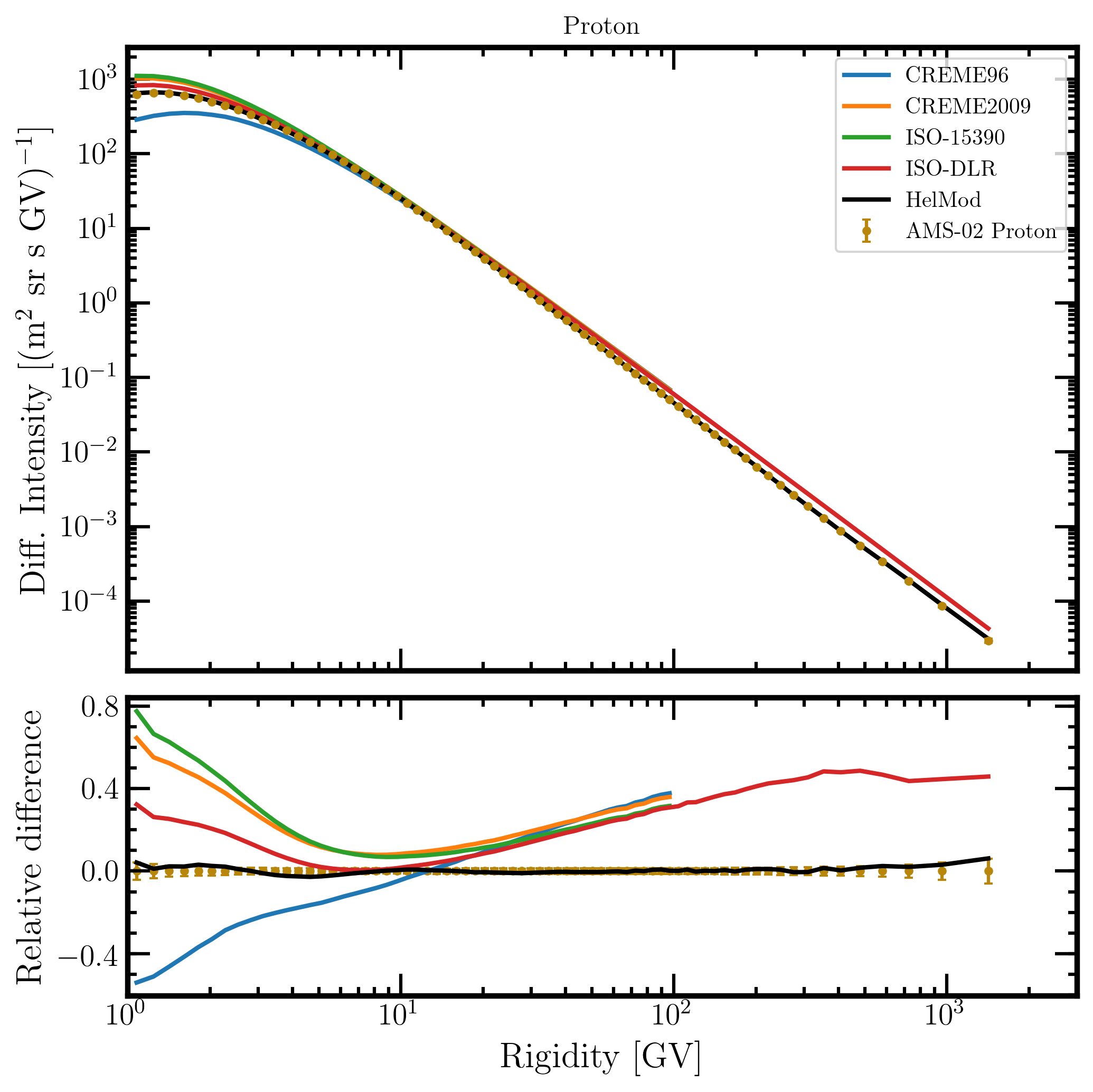
Figure 8. Upper panel: proton differential intensity in units of [m2 sr s GV]-1 measured by AMS-02 [Aguilar et al. (2015a)] (brown points) - previously shown in Figure 2 - as a function of rigidity in GV from May 19, 2011 to November 26, 2013 and proton differential intensities - calculated at 1AU during the same period - for the presently investigated modulation models: CREME96 (blue curve), CREME2009 (orange curve), ISO-15390 (green curve), ISO-DLR (red curve) and HelMod (black curve). Lower panel: relative differences with respect to AMS-02 data calculated using Eq. (1).
| (1.1, 2.815) GV | (2.815, 96.4) GV | (1.1, 96.4) GV | (1.1, 1417.3) GV | |||||
| Source of flux | Φ [(m2 s sr)-1] |
ΔΦ [%] |
Φ [(m2 s sr)-1] |
ΔΦ [%] |
Φ [(m2 s sr)-1] |
ΔΦ [%] |
Φ [(m2 s sr)-1] |
ΔΦ [%] |
| CREME96 | 1305.9 |
-38.1 |
1039.0 | -12.6 | 1341.6 | -25.3 | ||
| CREME2009 | 555.9 | 45.5 | 785.7 | 15.5 | 2344.9 | 30.5 | ||
| ISO-15390 | 1379.8 | 53.7 | 1045.6 | 16.3 | 2425.3 | 35.0 | ||
| ISO-DLR | 1095.6 | 22.1 | 947.5 | 5.4 | 2043.2 | 13.7 | 2046.9 | 13.7 |
| HelMod | 916.4 | 2.1 | 887.7 | -1.3 | 1804.1 | 0.4 | 1806.8 | 0.4 |
| AMS-02 | 897.5 (=49.87% of total) |
- | 899.4 (=49.98% of total) |
- | 1797.0 (=99.86% of total) |
- | 1799.6 (=total fluence) |
- |
Table 1. Proton fluences Φ in [m2 sr s]-1 from 1.1 GV to 96.4 GV for CREME96, CREME2009, ISO-15390, ISO-DLR and HelMod models and over the entire range covered by AMS-02 data, ISO-DLR and HelMod models. Their percentage difference (ΔΦ, see Eq. (2)) with respect to AMS-02 fluence is also reported.
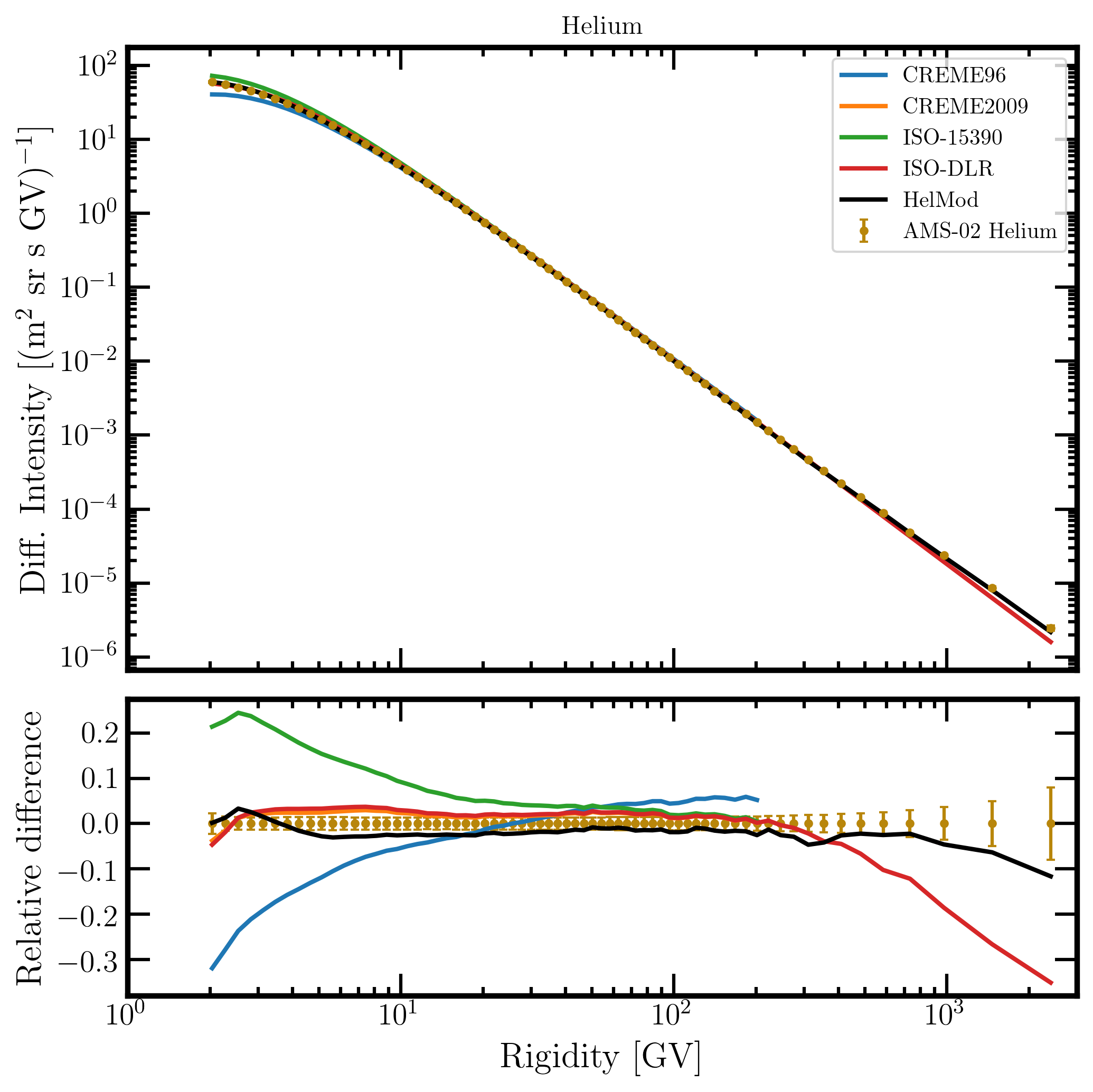
Figure 9. Upper panel: helium-nuclei differential intensity in units of [m2 sr s GV]-1 measured by AMS-02 [Aguilar et al. (2015b)] (brown points) - previously shown in Figure 2 - as a function of rigidity in GV from May 19, 2011 to November 26, 2013 and helium-nuclei differential intensities - calculated at 1AU during the same period - for the presently investigated modulation models: CREME96 (blue curve), CREME2009 (orange curve), ISO-15390 (green curve), ISO-DLR (red curve) and HelMod (black curve). Lower panel: relative differences with respect to AMS-02 data calculated using Eq. (1).
| (2.0, 4.225) GV | (4.225, 201.5) GV | (2.0, 201.5) GV | (2.0, 2400.0) GV | |||||
| Source of flux |
Φ |
ΔΦ [%] |
Φ [(m2 s sr)-1] |
ΔΦ [%] |
Φ [(m2 s sr)-1] |
ΔΦ [%] |
Φ [(m2 s sr)-1] |
ΔΦ [%] |
| CREME96 | 91.9 | -21.5 | 96.3 | -7.6 | 158.3 | -14.5 | ||
| CREME2009 | 71.4 | 1.1 | 86.9 | 2.4 | 188.2 | 1.7 | ||
| ISO-15390 | 111.0 | 22.0 | 105.0 | 11.6 | 215.9 | 16.7 | ||
| ISO-DLR | 92.2 | 1.3 | 96.9 | 3.1 | 189.1 | 2.2 | 189.3 | 2.2 |
| HelMod | 92.0 | 1.2 | 91.7 | -2.5 | 183.9 | -0.6 | 184.1 | -0.6 |
| AMS-02 | 90.9 (=49.12% of total) |
- | 94.0 (=50.78% of total) |
185.0 (=99.89% of total) |
- | 185.2 (=total fluence) |
- | |
Table 2. Helium-nuclei fluences Φ in [m2 sr s]-1 from 2.0 GV to 201.5 GV for CREME96, CREME2009, ISO-15390, ISO-DLR and HelMod models and over the entire range covered by AMS-02 data, ISO-DLR and HelMod models. Their percentage difference (ΔΦ, see Eq. (2)) with respect to AMS-02 fluence is also reported.
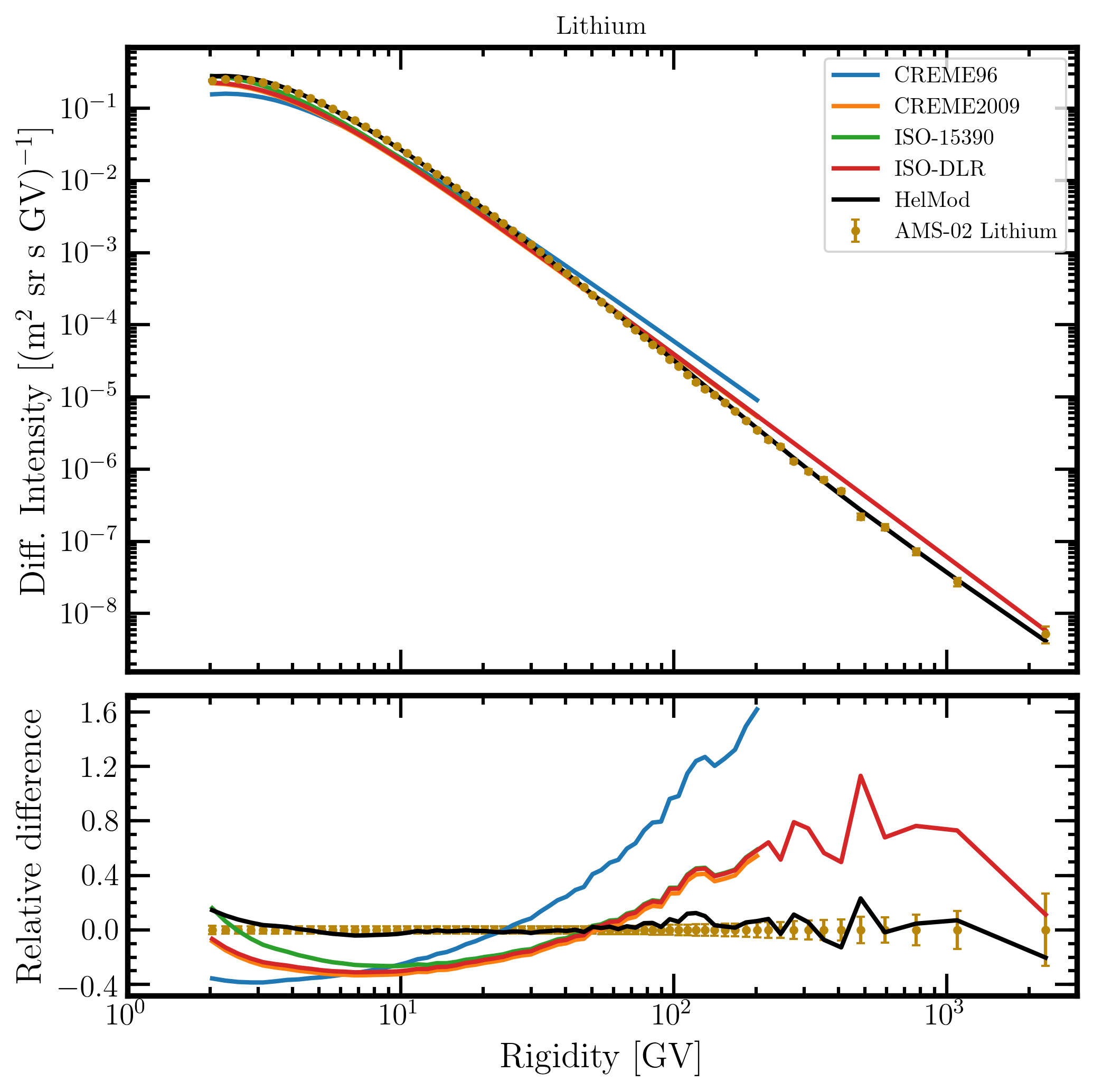
Figure 10. Upper panel: lithium-nuclei differential intensity in units of [m2 sr s GV]-1 measured by AMS-02 [M. Aguilar et al. (2018b)] (brown points) - previously shown in Figure 7 - as a function of rigidity in GV from May 19, 2011 to May 26, 2016 and lithium-nuclei differential intensities - calculated at 1AU during the same period of AMS-02 - for the presently investigated modulation models: CREME96 (blue curve), CREME2009 (orange curve), ISO-15390 (green curve), ISO-DLR (red curve) and HelMod (black curve). Lower panel: relative differences with respect to AMS-02 data calculated using Eq. (1).
| (2.0, 4.655) GV | (4.655, 201.5) GV | (2.0, 201.5) GV | (2.0, 2300.0) GV | |||||
| Source of flux | Φ [(m2 s sr)-1] |
ΔΦ [%] |
Φ [(m2 s sr)-1] |
ΔΦ [%] |
Φ [(m2 s sr)-1] |
ΔΦ [%] |
Φ [(m2 s sr)-1] |
ΔΦ [%] |
| CREME96 | 0.416 | -37.4 | 0.353 | -24.9 | 0.723 | -31.4 | ||
| CREME2009 | 0.342 | -23.9 | 0.381 | -30.4 | 0.769 | -27.1 | ||
| ISO-15390 | 0.503 | -8.1 | 0.389 | -23.3 | 0.892 | -15.4 | ||
| ISO-DLR | 0.429 | -21.6 | 0.364 | -28.2 | 0.793 | -24.8 | 0.793 | -24.7 |
| HelMod | 0.574 | 4.9 | 0.495 | -2.3 | 1.069 | 1.4 | 1.069 | 1.4 |
| AMS-02 | 0.547 (=51.90% of total) |
- | 0.507 (=48.07% of total) |
- | 1.054 (=99.96% of total) |
- | 1.054 (=total fluence) |
- |
Table 3. Lithium-nuclei fluences Φ in [m2 sr s]-1 from 2.0 GV to 201.5 GV for CREME96, CREME2009, ISO-15390, ISO-DLR and HelMod models and over the entire range covered by AMS-02 data, ISO-DLR and HelMod models. Their percentage difference (ΔΦ, see Eq. (2)) with respect to AMS-02 fluence is also reported.
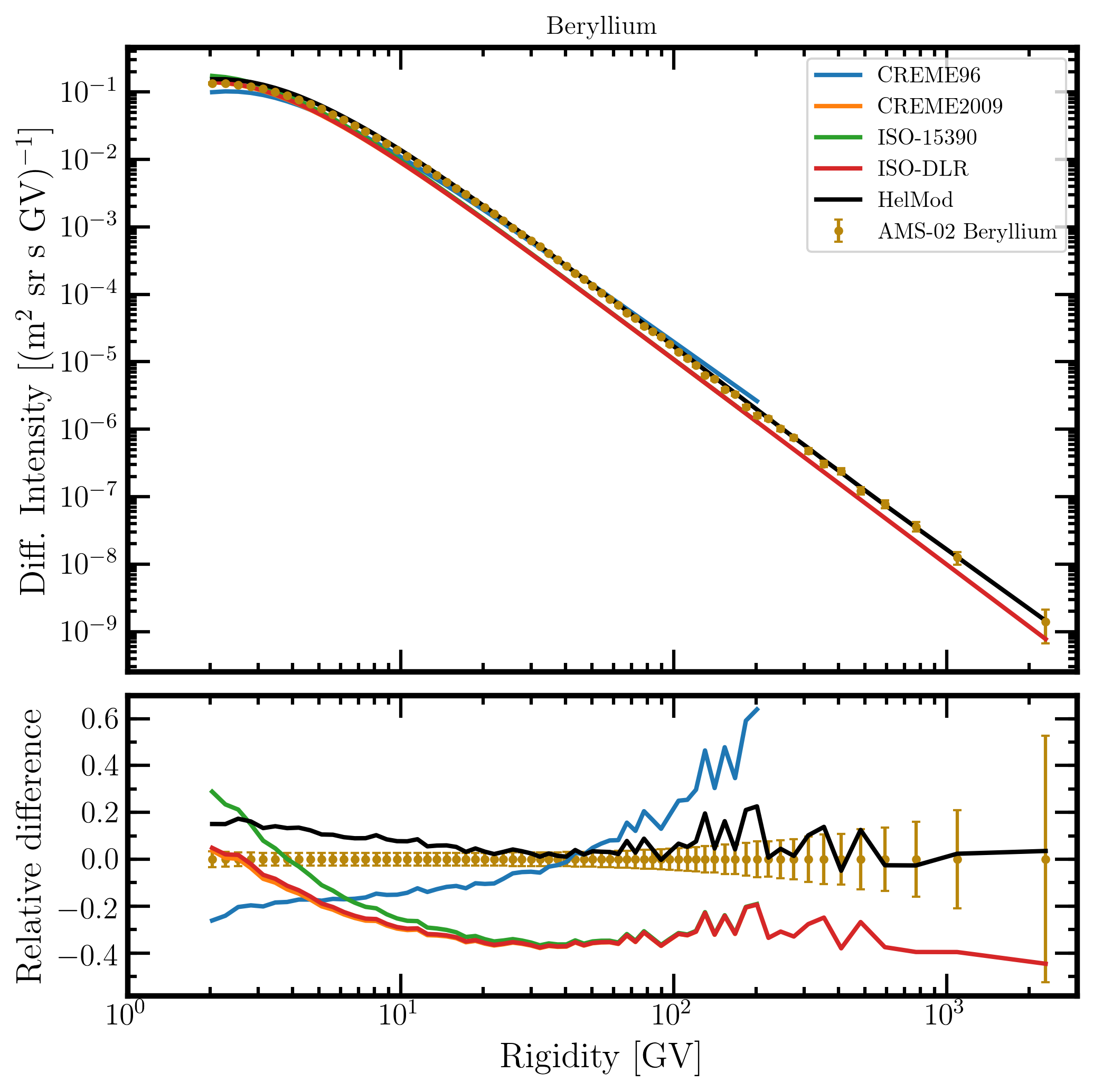
Figure 11. Upper panel: beryllium-nuclei differential intensity in units of [m2 sr s GV]-1 measured by AMS-02 [M. Aguilar et al. (2018b)] (brown points) - previously shown in Figure 6 - as a function of rigidity in GV from May 19, 2011 to May 26, 2016 and beryllium-nuclei differential intensities - calculated at 1AU during the same period of AMS-02 - for the presently investigated modulation models: CREME96 (blue curve), CREME2009 (orange curve), ISO-15390 (green curve), ISO-DLR (red curve) and HelMod (black curve). Lower panel: relative differences with respect to AMS-02 data calculated using Eq. (1).
| (2.0, 4.655) GV | (4.655, 201.5) GV | (2.0, 201.5) GV | (2.0, 2300.0) GV | |||||
| Source of flux | Φ [(m2 s sr)-1] |
ΔΦ [%] |
Φ [(m2 s sr)-1] |
ΔΦ [%] |
Φ [(m2 s sr)-1] |
ΔΦ [%] |
Φ [(m2 s sr)-1] |
ΔΦ [%] |
| CREME96 | 0.253 | -20.0 | 0.176 | -14.6 | 0.421 | -17.5 | ||
| CREME2009 | 0.217 | -6.8 | 0.204 | -26.6 | 0.428 | -16.1 | ||
| ISO-15390 | 0.299 | 10.2 | 0.189 | -20.8 | 0.488 | -4.3 | ||
| ISO-DLR | 0.257 | -5.2 | 0.178 | -25.7 | 0.435 | -14.8 | 0.435 | -14.8 |
| HelMod | 0.311 | 14.6 | 0.259 | 8.5 | 0.570 | 11.7 | 0.570 | 11.7 |
| AMS-02 | 0.271 (=53.11% of total) |
- | 0.239 (=46.85% of total) |
- | 0.510 (=99.96% of total) |
- | 0.510 (=total fluence) |
- |
Table 4. Beryllium-nuclei fluences Φ in [m2 sr s]-1 from 2.0 GV to 201.5 GV for CREME96, CREME2009, ISO-15390, ISO-DLR and HelMod models and over the entire range covered by AMS-02 data, ISO-DLR and HelMod models. Their percentage difference (ΔΦ, see Eq. (2)) with respect to AMS-02 fluence is also reported.
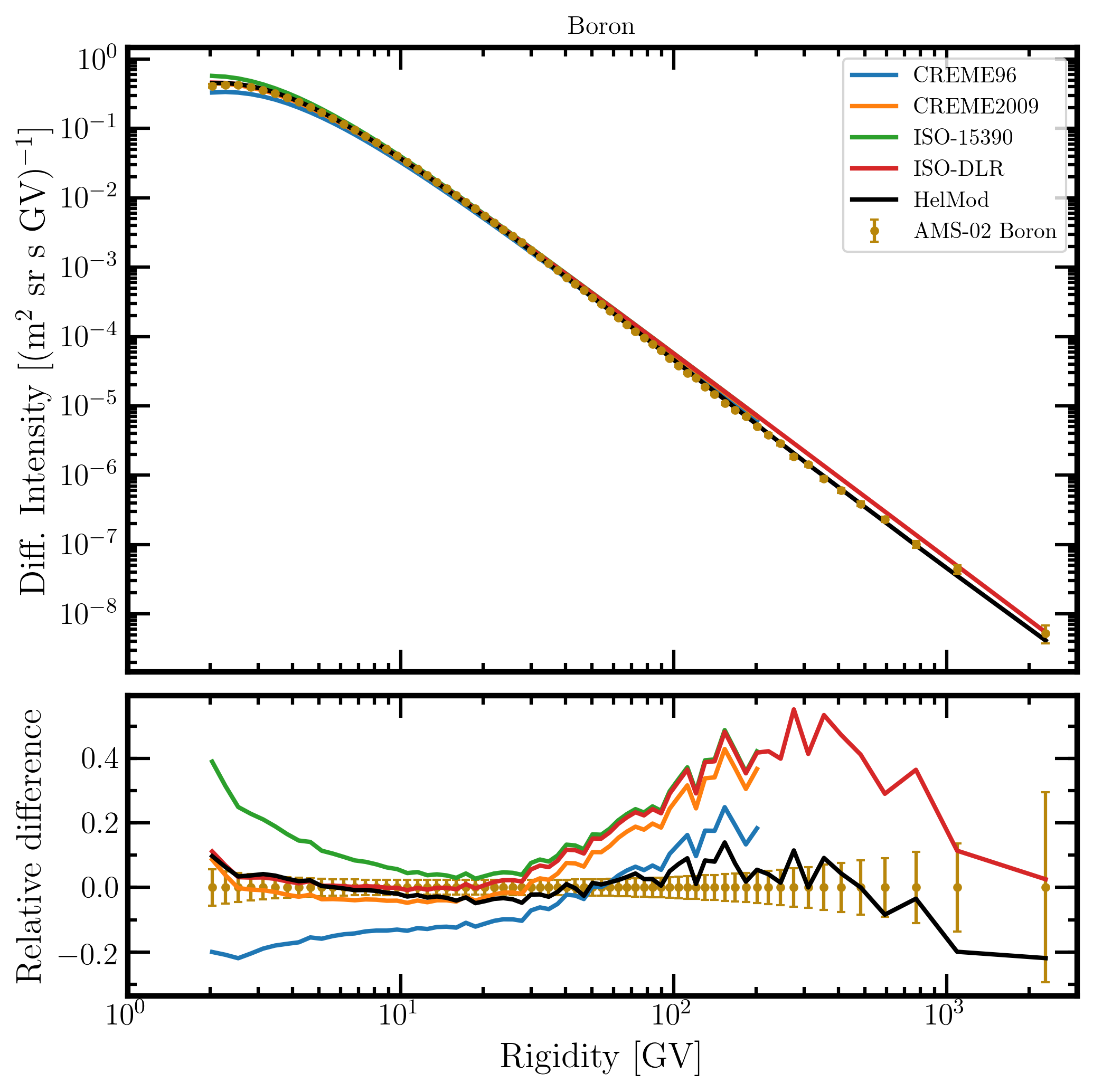
Figure 12. Upper panel: boron-nuclei differential intensity in units of [m2 sr s GV]-1 measured by AMS-02 [M. Aguilar et al. (2018b)] (brown points) - previously shown in Figure 6 - as a function of rigidity in GV from May 19, 2011 to May 26, 2016 and boron-nuclei differential intensities - calculated at 1AU during the same period of AMS-02 - for the presently investigated modulation models: CREME96 (blue curve), CREME2009 (orange curve), ISO-15390 (green curve), ISO-DLR (red curve) and HelMod (black curve). Lower panel: relative differences with respect to AMS-02 data calculated using Eq. (1).
| (2.0, 4.655) GV | (4.655, 201.5) GV | (2.0, 201.5) GV | (2.0, 2300.0) GV | |||||
| Source of flux | Φ [(m2 s sr)-1] |
ΔΦ [%] |
Φ [(m2 s sr)-1] |
ΔΦ [%] |
Φ [(m2 s sr)-1] |
ΔΦ [%] |
Φ [(m2 s sr)-1] |
ΔΦ [%] |
| CREME96 | 0.862 | -19.2 | 0.689 | -13.4 | 1.316 | -16.6 | ||
| CREME2009 | 0.698 | -0.2 | 0.616 | -3.2 | 1.553 | -1.5 | ||
| ISO-15390 | 1.056 | 22.2 | 0.770 | 8.2 | 1.826 | 15.9 | ||
| ISO-DLR | 0.894 | 3.6 | 0.718 | 0.8 | 1.612 | 2.3 | 1.613 | 2.3 |
| HelMod | 0.898 | 4.0 | 0.705 | -1.0 | 1.603 | 1.7 | 1.603 | 1.7 |
| AMS-02 | 0.864 (=54.80% of total) |
- | 0.712 (=45.17% of total) |
- | 1.576 (=99.97% of total) |
- | 1.576 (=total fluence) |
- |
Table 5. Boron-nuclei fluences Φ in [m2 sr s]-1 from 2.0 GV to 201.5 GV for CREME96, CREME2009, ISO-15390, ISO-DLR and HelMod models and over the entire range covered by AMS-02 data, ISO-DLR and HelMod models. Their percentage difference (ΔΦ, see Eq. (2)) with respect to AMS-02 fluence is also reported.
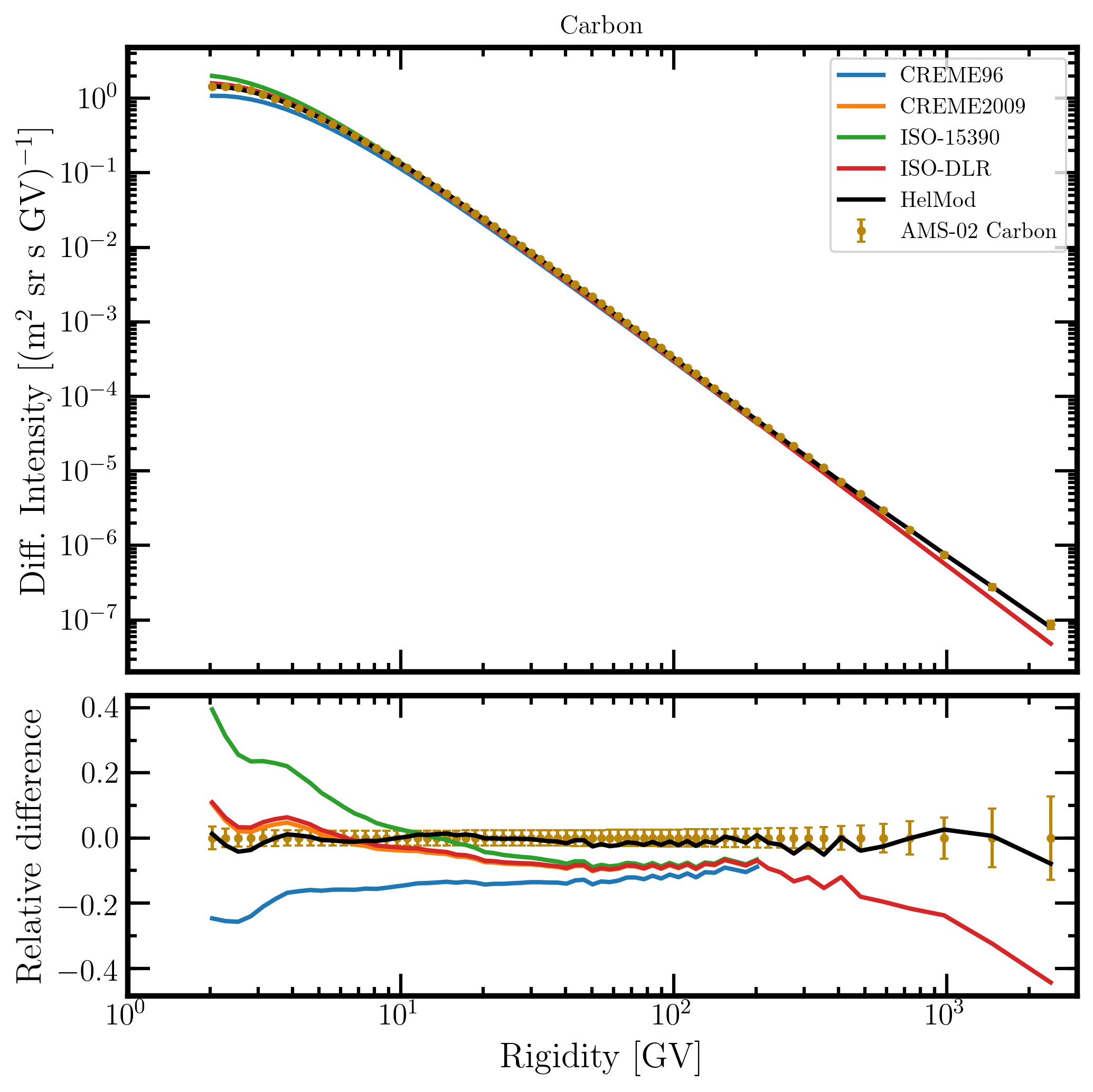
Figure 13. Upper panel: carbon-nuclei differential intensity in units of [m2 sr s GV]-1 measured by AMS-02 [Aguilar et al. (2017)] (brown points) - previously shown in Figure 4 - as a function of rigidity in GV from May 19, 2011 to May 19, 2016 and carbon-nuclei differential intensities - calculated at 1AU during same period of AMS-02 - for the presently investigated modulation models: CREME96 (blue curve), CREME2009 (orange curve), ISO-15390 (green curve), ISO-DLR (red curve) and HelMod (black curve). Lower panel: relative differences with respect to AMS-02 data calculated using Eq. (1).
| (2.0, 4.655) GV | (4.655, 201.5) GV | (2.0, 201.5) GV | (2.0, 2400.0) GV | |||||
| Source of flux | Φ [(m2 s sr)-1] |
ΔΦ [%] |
Φ [(m2 s sr)-1] |
ΔΦ [%] |
Φ [(m2 s sr)-1] |
ΔΦ [%] |
Φ [(m2 s sr)-1] |
ΔΦ [%] |
| CREME96 | 2.867 | -21.4 | 2.437 | -15.1 | 4.298 | -18.4 | ||
| CREME2009 | 2.169 | 4.0 | 2.129 | -2.8 | 5.304 | 0.7 | ||
| ISO-15390 | 3.443 | 24.8 | 2.639 | 5.3 | 6.082 | 15.5 | ||
| ISO-DLR | 2.904 | 5.3 | 2.461 | -1.8 | 5.365 | 1.9 | 5.370 | 1.9 |
| HelMod | 2.723 | -1.3 | 2.498 | -0.3 | 5.222 | -0.8 | 5.227 | -0.8 |
| AMS-02 | 2.758 (=52.33% of total) |
- | 2.507 (=47.56% of total) |
- | 5.265 (=99.89% of total) |
- | 5.271 | - |
Table 6. Carbon-nuclei fluences Φ in [m2 sr s]-1 from 2.0 GV to 201.5 GV for CREME96, CREME2009, ISO-15390, ISO-DLR and HelMod models and over the entire range covered by AMS-02 data, ISO-DLR and HelMod models. Their percentage difference (ΔΦ, see Eq. (2)) with respect to AMS-02 fluence is also reported.
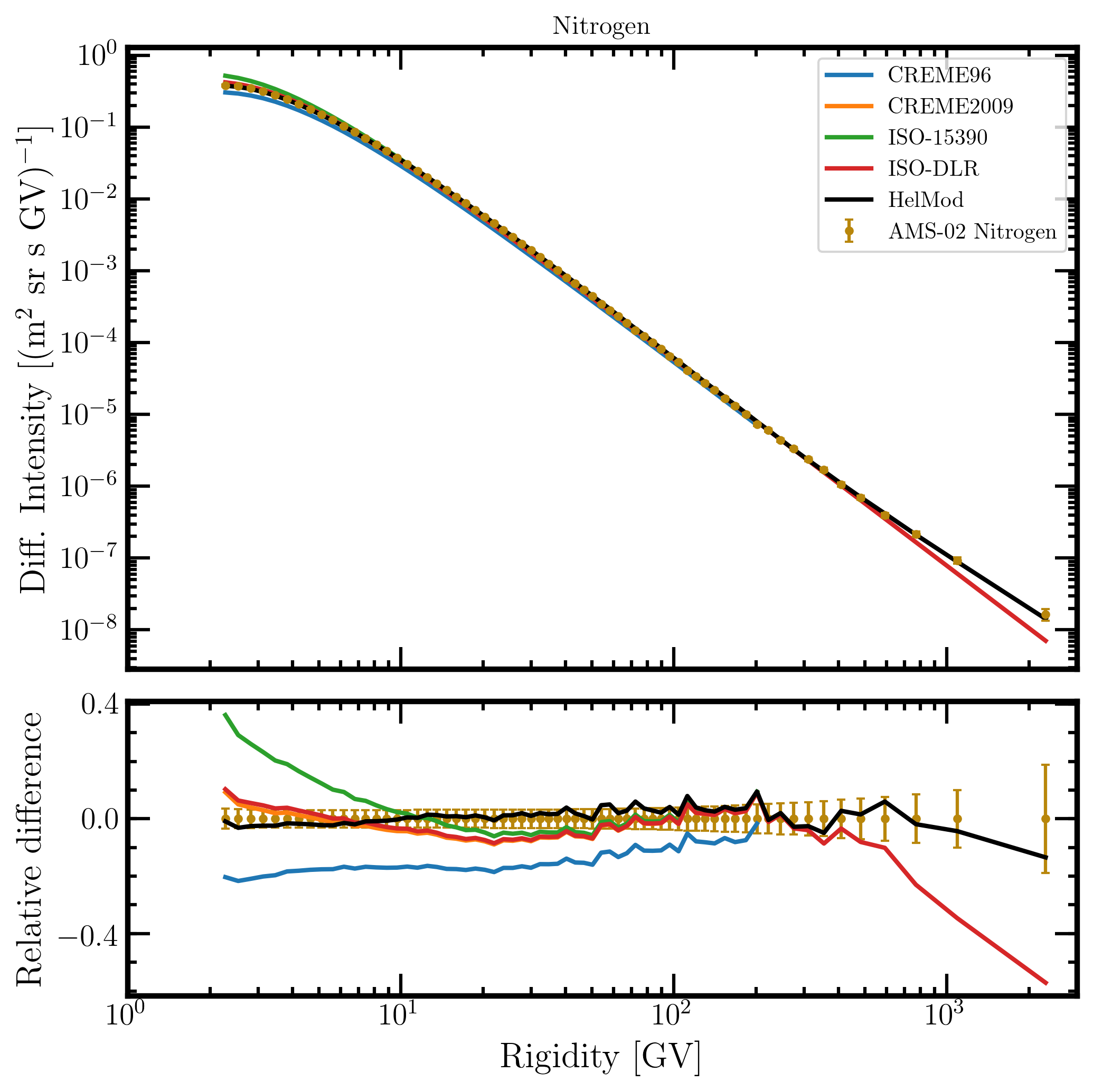
Figure 14. Upper panel: nitrogen-nuclei differential intensity in units of [m2 sr s GV]-1 measured by AMS-02 [M. Aguilar et al. (2018c)] (brown points) - previously shown in Figure 6 - as a function of rigidity in GV from May 19, 2011 to May 26, 2016 and nitrogen-nuclei differential intensities - calculated at 1AU during the same period of AMS-02 - for the presently investigated modulation models: CREME96 (blue curve), CREME2009 (orange curve), ISO-15390 (green curve), ISO-DLR (red curve) and HelMod (black curve). Lower panel: relative differences with respect to AMS-02 data calculated using Eq. (1).
| (2.3, 4.655) GV | (4.655, 201.5) GV | (2.3, 201.5) GV | (2.3, 2300.0) GV | |||||
| Source of flux | Φ [(m2 s sr)-1] |
ΔΦ [%] |
Φ [(m2 s sr)-1] |
ΔΦ [%] |
Φ [(m2 s sr)-1] |
ΔΦ [%] |
Φ [(m2 s sr)-1] |
ΔΦ [%] |
| CREME96 | 0.697 | -19.8 | 0.640 | -17.1 | 1.090 | -18.4 | ||
| CREME2009 | 0.541 | 3.3 | 0.548 | -3.1 | 1.337 | 0.1 | ||
| ISO-15390 | 0.831 | 23.2 | 0.695 | 5.1 | 1.526 | 14.2 | ||
| ISO-DLR | 0.708 | 4.8 | 0.647 | -2.1 | 1.355 | 1.4 | 1.356 | 1.4 |
| HelMod | 0.660 | -2.2 | 0.656 | -0.7 | 1.316 | -1.5 | 1.317 | -1.5 |
| AMS-02 | 0.675 (=50.49% of total) |
- | 0.661 (=49.44% of total) |
- | 1.336 (=99.93% of total) |
- | 1.337 | - |
Table 7. Nitrogen-nuclei fluences Φ in [m2 sr s]-1 from 2.3 GV to 201.5 GV for CREME96, CREME200, ISO-15390, ISO-DLR and HelMod models and over the entire range covered by AMS-02 data, ISO-DLR and HelMod models. Their percentage difference (ΔΦ, see Eq. (2)) with respect to AMS-02 fluence is also reported.
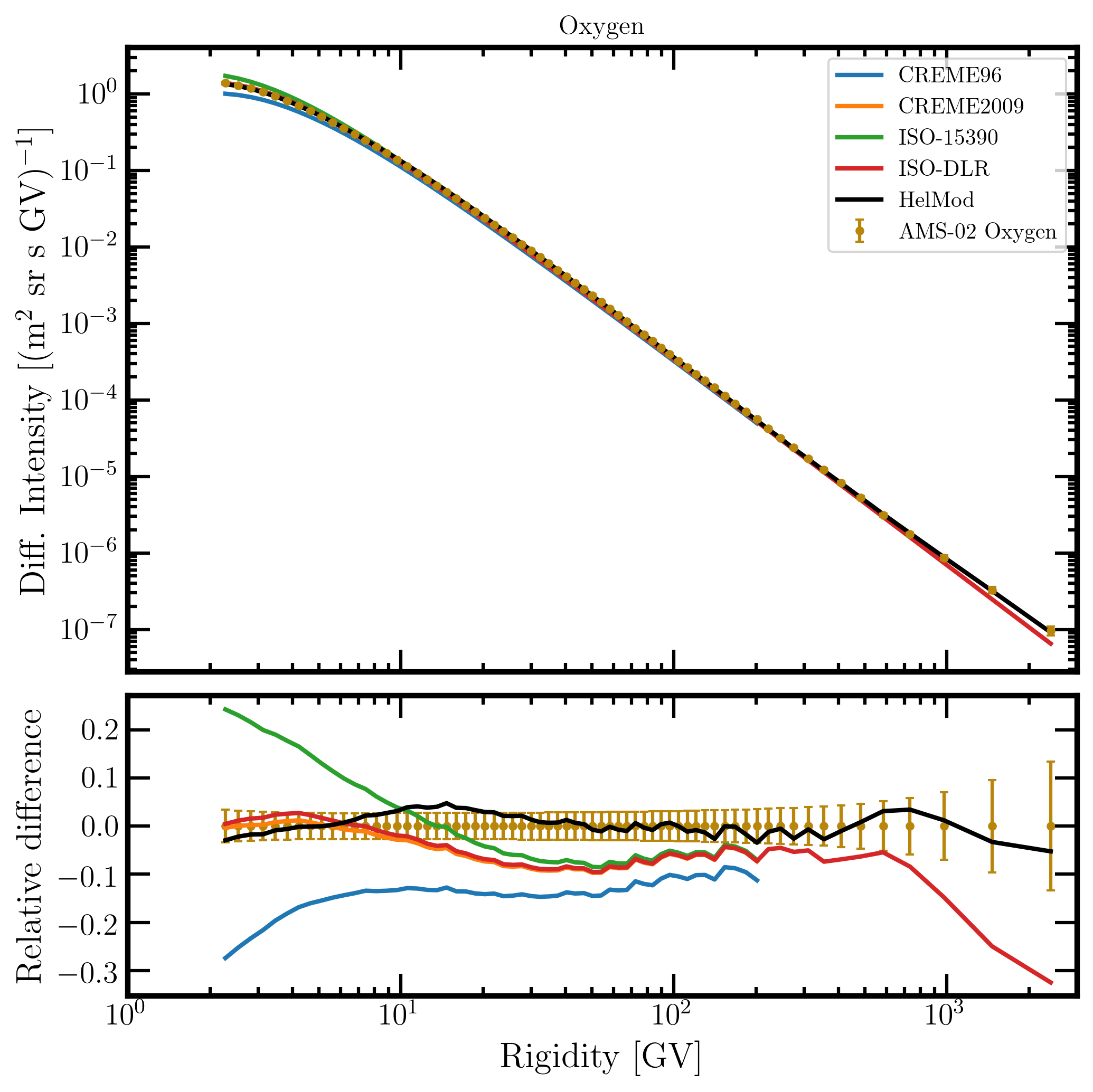
Figure 15. Upper panel: oxygen-nuclei differential intensity in units of [m2 sr s GV]-1 measured by AMS-02 [Aguilar et al. (2017)] (brown points) - previously shown in Figure 5 - as a function of rigidity in GV from May 19, 2011 to May 19, 2016 and oxygen-nuclei differential intensities - calculated at 1AU during the same period of AMS-02 - for the presently investigated modulation models: CREME96 (blue curve), CREME2009 (orange curve), ISO-15390 (green curve), ISO-DLR (red curve) and HelMod (black curve). Lower panel: relative differences with respect to AMS-02 data calculated using Eq. (1).
| (2.3, 5.125) GV | (5.125, 201.5) GV | (2.3, 201.5) GV | (2.3, 2400.0) GV | |||||
| Source of flux | Φ [(m2 s sr)-1] |
ΔΦ [%] |
Φ [(m2 s sr)-1] |
ΔΦ [%] |
Φ [(m2 s sr)-1] |
ΔΦ [%] |
Φ [(m2 s sr)-1] |
ΔΦ [%] |
| CREME96 | 2.557 | -20.7 | 2.107 | -13.8 | 3.890 | -17.5 | ||
| CREME2009 | 2.019 | 0.5 | 1.872 | -3.0 | 4.664 | -1.1 | ||
| ISO-15390 | 3.034 | 19.2 | 2.226 | 4.3 | 5.299 | 12.4 | ||
| ISO-DLR | 2.592 | 1.9 | 2.126 | -2.1 | 4.719 | 0.04 | 4.725 | 0.03 |
| HelMod | 2.514 | -1.2 | 2.217 | 2.1 | 4.731 | 0.3 | 4.737 | 0.3 |
| AMS-02 | 2.544 (=53.87% of total) |
- | 2.172 (=45.99% of total) |
- | 4.716 (=99.85% of total) |
- | 4.723 | - |
Table 8. Oxygen-nuclei fluences Φ in [m2 sr s]-1 from 2.3 GV to 201.5 GV for CREME96, CREME2009, ISO-15390, ISO-DLR and HelMod models and over the entire range covered by AMS-02 data, ISO-DLR and HelMod models. Their percentage difference (ΔΦ, see Eq. (2)) with respect to AMS-02 fluence is also reported.
By inspection of Figures 8-15, one can remark that HelMod model exhibit an overall better agreement with AMS-02 data when compared to the other solar modulation models here presented.
A further comparison among solar modulation models and observations was carried out by investigating how the expectations values differ from the experimental ones within the experimental errors, i.e., computing the quantity [Bobik et al. (2012)] (see Table 9)
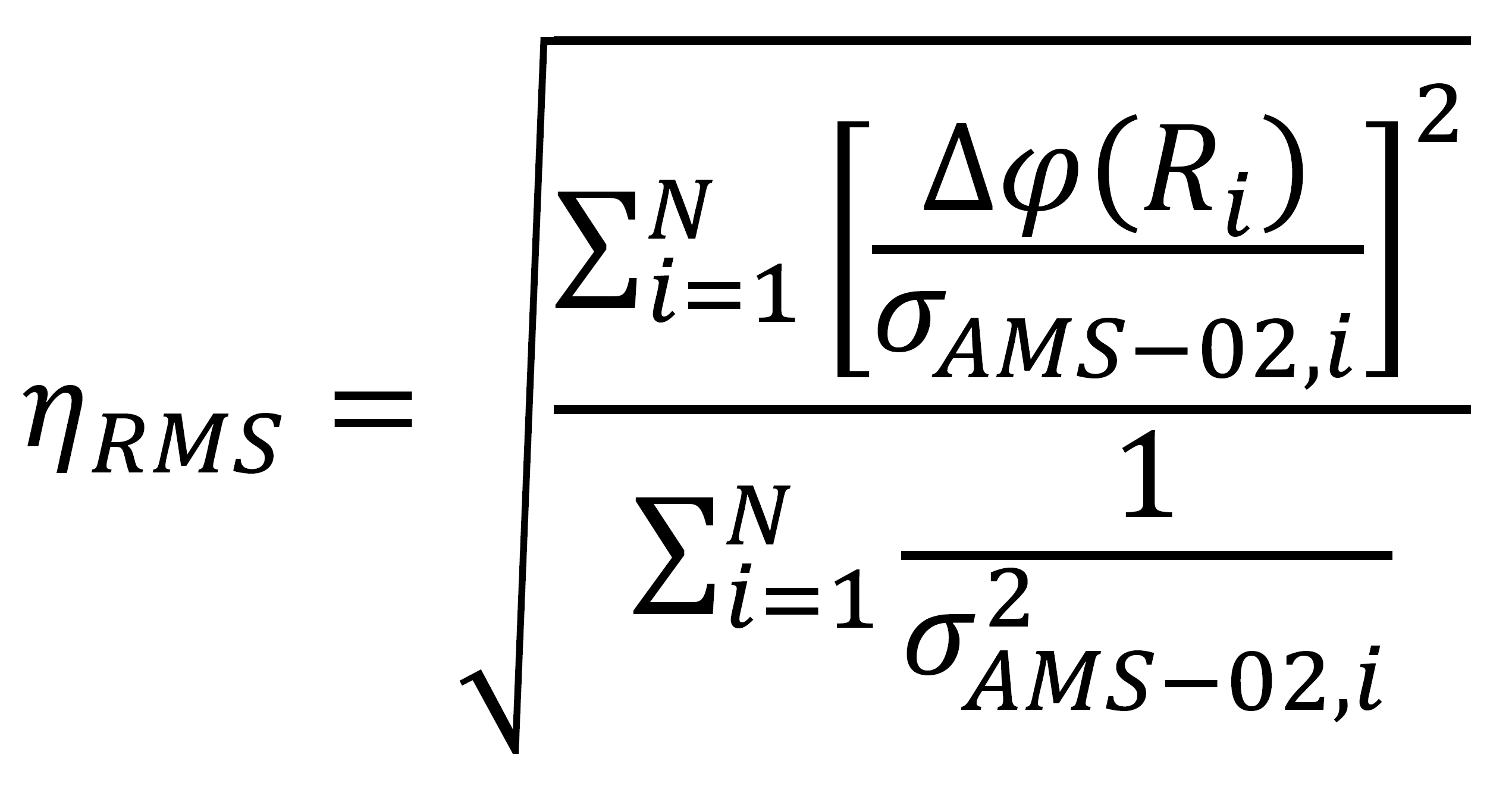 , (3)
, (3)
where σAMS-02,i is the AMS-02 experimental relative error for the i-th data point and Δφ(Ri) is obtained using Eq. (1).
| p | He | Li | Be | B | C | N | O | |
| CREME96 | 21.2 | 8.9 | 47.3 | 16.2 | 11.8 | 14.8 | 16.0 | 14.5 |
| CREME2009 | 22.4 | 2.0 | 25.7 | 29.6 | 12.0 | 6.9 | 5.0 | 6.1 |
| ISO-15390 | 21.5 | 10.2 | 21.5 | 27.8 | 16.4 | 11.2 | 10.5 | 9.5 |
| ISO-DLR | 15.6 | 2.4 | 24.6 | 29.2 | 14.2 | 6.8 | 4.9 | 6.0 |
| HelMod | 1.1 | 1.9 | 4.1 | 8.7 | 3.5 | 1.4 | 2.6 | 2.2 |
| ISO-DLR - Full range | 22.0 | 3.1 | 26.7 | 29.2 | 15.7 | 7.8 | 5.4 | 6.1 |
| HelMod - Full range | 1.1 | 2.0 | 4.3 | 8.7 | 3.7 | 1.6 | 2.1 | 2.1 |
Table 9. Computed values of the quantity ηRMS in percentage for protons, helium-, lithium-, beryllium-, boron-, carbon-, nitrogen- and oxygen-nuclei from Eqs. (3) as a function of the solar modulation model for the incoming particle rigidity up to 96.4 GV for protons and 201.5GV for the other nuclei. For both ISO-DLR and HelMod models such a quantity was also computed for the entire rigidity range available.
By inspection of Table 9, one can remark that HelMod model again exhibit an overall better agreement with AMS-02 data when compared to the other solar modulation models here investigated.
In addition, HelMod model is capable of providing the expected differential intensities for GCRs species in any heliospheric position (e.g., see Figure 1, discussions in [Boschini et al. (2019a)] and references therein).
Bibliography
[Adriani et al. (2011)] Adriani, O. et al. (2011). Cosmic-Ray Electron Flux Measured by the PAMELA Experiment between 1 and 625 GeV, Phys. Rev. Lett. 106, 201101, doi:10.1103/PhysRevLett.106.201101.
[Adriani et al. (2014)] Adriani, O. et al. (PAMELA Collaboration) (2014), MEASUREMENT OF BORON AND CARBON FLUXES IN COSMIC RAYS WITH THE PAMELA EXPERIMENT, ApJ, 791, 93, doi:10.1088/0004-637X/791/2/93.
[ANSI (2004)] American National Standards Institute, Space environment (natural and artificial) – Galactic cosmic ray model (2004). Tech. Rep. ISO 15390, Washington, D.C.. Retrieved from https://www.iso.org/standard/37095.html.
[Aguilar et al. (2014)] Aguilar, M. et al. (AMS Collaboration) (2014). Electron and Positron Fluxes in Primary Cosmic Rays Measured with the Alpha Magnetic Spectrometer on the International Space Station, Phys. Rev. Lett. 113, 121102, doi:10.1103/PhysRevLett.113.121102.
[Aguilar et al. (2015a)] Aguilar, M. et al. (AMS Collaboration) (2015). Precision Measurement of the Proton Flux in Primary Cosmic Rays from Rigidity 1 GV to 1.8 TV with the Alpha Magnetic Spectrometer on the International Space Station, Phys. Rev. Lett. 114, 171103, doi:10.1103/PhysRevLett.114.171103.
[Aguilar et al. (2015b)] Aguilar, M. et al. (AMS Collaboration) (2015). Precision Measurement of the Helium Flux in Primary Cosmic Rays of Rigidities 1.9 GV to 3 TV with the Alpha Magnetic Spectrometer on the International Space Station, Phys. Rev. Lett. 115, 211101, doi:10.1103/PhysRevLett.115.211101.
[Aguilar et al. (2017)] Aguilar, M. et al. (AMS Collaboration) (2017). Observation of the Identical Rigidity Dependence of He, C, and O Cosmic Rays at High Rigidities by the Alpha Magnetic Spectrometer on the International Space Station, Phys. Rev. Lett. 119, 251101, doi:10.1103/PhysRevLett.119.251101.
[Aguilar et al. (2018b)] Aguilar, M. et al. (AMS Collaboration) (2018), Observation of New Properties of Secondary Cosmic Rays Lithium, Beryllium, and Boron by the Alpha Magnetic Spectrometer on the International Space Station, Phys. Rev. Lett. 120, 021101, doi:10.1103/PhysRevLett.120.021101.
[Bobik et al. (2012)] Bobik, P. et al. (2012), Systematic Investigation of Solar Modulation of Galactic Protons for Solar Cycle 23 Using a Monte Carlo Approach with Particle Drift Effects and Latitudinal Dependence, Astrophys. J. 745:132, doi:10.1088/0004-637X/745/2/132.
[Boschini et al. (2017)] Boschini, M. J. et al. (2017). Solution of Heliospheric Propagation: Unveiling the Local Interstellar Spectrum of Cosmic Rays Species, Astrophysical Journal, 840:115, doi:10.3847/1538-4357/aa6e4f.
[Boschini et al. (2018a)] Boschini, M. J. et al. (2018). HelMod In The Works: From Direct Observations To The Local Interstellar Spectrum Of Cosmic-Ray Electrons, Astrophys. J. 854(2):94, doi:10.3847/1538-4357/aaa75e.
[Boschini et al. (2018b)] Boschini, M. J. et al. (2018). Deciphering the Local Interstellar Spectra of Primary Cosmic-Ray Species with HelMod, Astrophys. J. 858(1):61, doi:10.3847/1538-4357/aabc54.
[Boschini et al. (2019a)] M.J. Boschini, S. Della Torre, M. Gervasi, G. La Vacca and P.G. Rancoita, The HelMod Model in the Works for Inner and Outer Heliosphere: from AMS to Voyager Probes Observations, Advances in Space Res 64 (2019), 2459-2476 - https://doi.org/10.1016/j.asr.2019.04.007 -; available also at the website: https://arxiv.org/abs/1903.07501.
[Boschini et al. (2019b)] Boschini, M. J. et al. (2019), Deciphering the Local Interstellar Spectra of Secondary Nuclei with the Galprop/Helmod Framework and a Hint for Primary Lithium in Cosmic Rays, Astrophys. J. 889:167, 2020, ArXiv 1911.03108.
[CREME (1996)] Tylka, A. J. et al. (1997). CREME96: A Revision of the Cosmic Ray Effects on Micro-Electronics Code, IEEE Trans. Nucl. Sci., 44, 2150-2160, 1997.; Badhwar, G.D. and O'Neill, P.M. (1996), Galactic cosmic radiation model and its applications, Ad. Sp. Res. 17, 7-17; and also: Badhwar, G.D. and O'Neill, P.M. (1992), An improved model of galactic cosmic radiation for space exploration missions, International Journal of Radiation Applications and Instrumentation. Part D. Nuclear Tracks and Radiation Measurements, Volume 20, Issue 3, 403-410, https://doi.org/10.1016/1359-0189(92)90024-P.
[CREME (2012)] Adams, J.H. et al. (2012). CRÈME: The 2011 Revision of the Cosmic Ray Effects on Micro-Electronics Code, IEEE Tran. Nucl. Scie. 59, 3141 - 3147.
[GalProp-HelMod (2016)] GalProp-HelMod (2016). As advertised on the GALPROP website, HelMod website can be used as a service package to seamlessly calculate the effects of the heliospheric modulation for GALPROP output files. FROM GalProp homepage: "We are pleased to inform the community of the launch of a new service HelMod, which can be used to seamlessly calculate the effects of the heliospheric modulation for GALPROP output file".
[George et al. (2009)] George, J. S. et al. (2009), ELEMENTAL COMPOSITION AND ENERGY SPECTRA OF GALACTIC COSMIC RAYS DURING SOLAR CYCLE 23, ApJ, 698, 1666, doi:10.1088/0004-637X/698/2/1666.
[HelMod (2019)] See [Boschini et al. (2019a)], [Boschini et al. (2019b)], [Boschini et al. (2018a)], [Boschini et al. (2018b)], [Boschini et al. (2017)], [Bobik et al. (2012)]; see also: Bobik et al. (2016), On the forward-backward-in-time approach for Monte Carlo solution of Parker's transport equation: One-dimensional case, Journal of Geophysical Research - Space Physics 121(5), 3920–3930, doi:10.1002/2015JA022237.
[Leroy and Rancoita (2016)] C. Leroy and P.G. Rancoita (2016), Principles of Radiation Interaction in Matter and Detection - 4th Edition -, World Scientific. Singapore, ISBN-978-981-4603-18-8 (printed); ISBN.978-981-4603-19-5 (ebook); https://www.worldscientific.com/worldscibooks/10.1142/9167#t=aboutBook; it is also partially accessible via google books.
[Matthiä et al (2013)] Matthiä D., Berger T., Mrigakshi A. I., Reitz G. (2013), A ready-to-use galactic cosmic ray model, Advances in Space Research, Volume 51, Issue 3, Pages 329-338, https://doi.org/10.1016/j.asr.2012.09.022.
[NASA-Voyager (2018)] NASA-Voyager (2018), Online Database, https://voyager.gsfc.nasa.gov/flux.html.
